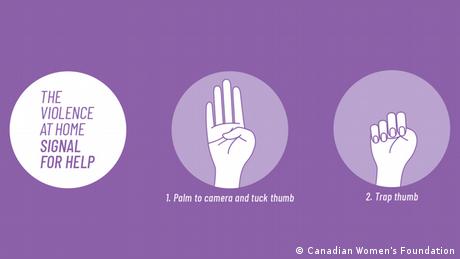TikTok hand signal: Is social media the next frontier to battle domestic violence?

When countries around the world first started going into lockdown in early 2020, women’s organizations had to think of ways to help people who might be trapped at home with their abusers.
One of them, the Canadian Women’s Foundation, came up with a hand signal to show that one is in distress: tucking one’s thumb into the palm and curling the other fingers around it.
The idea was to come up with a signal that could be shared on a video call silently without leaving a digital trace, said Suzanne Duncan, vice president of philanthropy at the foundation.
Over the past year, the gesture took on a life of its own in viral TikTok videos where users raise awareness about the signal, acting out scenarios in which women might use it to show they are in danger. Some of these clips have racked up millions of views.
Last week, in the most high-profile case of it being used, a 16-year-old girl in the state of Kentucky in the United States was rescued after repeatedly flashing the hand signal from a car. Another driver on the highway recognized it and called 911, which led to the arrest of her alleged kidnapper, a 61-year-old man.
“We didn’t even know what [the signal] meant. We do now,” said Deputy Gilbert Acciardo from the Laurel county sheriff’s office.
Calling for help on social media around the world
But the gesture, popularized on TikTok, is not the only example of people using social media to combat domestic and gender-based violence.
Polish teenager Krystyna Paszko collaborated with a nongovernmental organization to set up a fake online cosmetics shop for creams and gels where victims could secretly ask for help by pretending to buy a product. If the user provides her address to order the product, it actually means she is asking for someone to call the police.
“People experiencing domestic violence have no alternative — they cannot leave their home, go to work, shop, meet friends or even go for a walk, and often spend their days trapped in a small space with their perpetrators,” Paszko told DW.
In Brazil, a woman was rescued from her abuser after she shared an Instagram story showing her hand with a red cross on it. This signal was part of a national campaign.
Duncan said that one of the reasons such types of resources are useful on social media is because there, they reach the most vulnerable.
“We know that younger women and younger gender diverse people are at most risk for gender-based violence,” she said. A large proportion of people on social media are young people. “So it really makes sense that folks on social media platforms saw our signal.”
What if the abusers also know?
Many social media users have questioned whether secret signals are still effective if they go viral on the internet, where abusers might also become familiar with them.
In the case of the hand signal developed by the Canadian Women’s Foundation, some TikTok accounts point out that victims can still make the gesture without their abuser noticing, exactly because it is silent and does not leave a trace.
Duncan also emphasized that combatting domestic abuse is about diversifying the ways people can ask for help. In other cases, calling a crisis line or contacting a shelter may be more appropriate.
“The signal is only one tool,” she concluded. “We need to have a whole toolbox of tools to let people know we need help.”
SOURCE: DW News
Join the conversation and have your say on Thailand news published on The Thaiger.
Thaiger Talk is our new Thaiger Community where you can join the discussion on everything happening in Thailand right now.
Please note that articles are not posted to the forum instantly and can take up to 20 min before being visible. Click for more information and the Thaiger Talk Guidelines.









